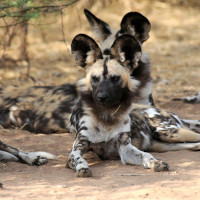 |
African Gorilla Dog |
|
He is a wild animal |
Origin |
Africa | |
Translation |
Francis Vandersteen | |
This breed is also known as |
African wild dog
|
| The possession of this animal is not authorized Royal Decree establishing the list of mammals not kept for production purposes that may be kept (M.B. 24.08.2009) |
| The African wild dog, also known as the hunting dog, is an endangered species in East Africa. Field studies have shown that the wild dog is a highly intelligent and social animal. Like most predators, it plays an important role in eliminating weak and struggling animals, thereby helping to maintain a normal balance and ultimately improving the species. The stereotype of the wild dog as a cruel butcher has slowly been replaced by a less harsh image. The African wild dog is long-legged, with massive jaws and very large, upright ears. Although it resembles some domestic dogs, it differs because it has four toes on each foot instead of five. The Latin name for African wild dogs "painted wolf" aptly describes the colorful coat of brown, black and dark yellow spots. Wild dogs have bushy tails with white tips that can be used as a flag to keep in touch with the group during hunting. Wild dogs live mostly in arid areas and savannah. They are also found in wooded and mountainous areas where their prey lives. Wild dogs live in groups of 6 to 20 individuals. If group numbers fall below 6, hunting efficiency is eroded. The dogs have a rather mischievous and peculiar ceremony, sticking together before the hunt. They begin to circulate among the other members of the group, vocalizing and touching until they are ready to hunt. They begin the hunt in an organized, cooperative manner. When the prey is targeted, some of the dogs charge close to the animal, while others follow, taking turns when the group leader is tired. They can run long distances, accelerating to around 60 km/hour. Of the large carnivores, wild dogs are the most efficient hunters. They tear flesh until the animal falls, consuming it even if it's still alive. This behavior can compromise people, although in reality it may be no worse than the prolonged killing of other carnivores. Regardless of its undeniable bloodthirstiness, the remarkable aspect of their hunt is the complete lack of aggression towards one another. Unlike many other social animals, wild dogs have a social hierarchy, with little obvious intimidation. They have a refined ritual of greeting, chirping and whining. Their extensive range of vocalizations includes a short alarm sound, a rallying howl that can be heard from long distances. They usually hunt early in the morning and again in the late evening, mainly on gazelles and other antelopes, wild pigs, wildebeest and rats and birds. They may pillage domestic places, but wild dogs rarely stay in such a place for long, such damage is not extensive. A group of around six dogs usually consists of a dominant breeding pair and several adult males not yet breeding. Occasionally, another female in the group forms a subordinate breeding pair with one of these other males. A breeding female gives birth once a year, with litters averaging 10 puppies, although one litter of 19 puppies has been recorded. Puppies are born in a shelter of bushes or thick grass, or in a burrow. Usually, twice as many males are born. Unlike many other species, the reproductively mature female leaves the group when she reaches maturity, not the males. The group's hunters return to the den to hunt. The group's hunters return to the den with plenty of meat for the female and the pups. Although the litters are very large, very few pups survive. Sometimes the dens are flooded, or the pups die from sun exposure or disease. When group numbers are reduced, hunting is not as efficient and the adults may not bring back enough food for the puppies. The whole group is involved in the puppies' welfare; males and females look after the children and provide them with food. Throughout Africa wild dogs have been shot and poisoned by farmers, hunters and, at the same time, by forest rangers who have regarded them as bloodthirsty rustlers of cattle and dispersers of wild herds. As the number of these wild dogs diminishes, they become more mysterious, evasive and enigmatic, suddenly reappearing in places they haven't inhabited for months and then disappearing again a few days later. Although protected in parks and reserves, the wild population of these dogs has dwindled to the point where groups can no longer be viable. In some areas, they are close to extinction. None of the wild dogs are marked in exactly the same way, making them easy to identify between different individuals. Why such a pattern had to develop, and what the wild hound is used for, has long puzzled scientists. Wild dogs are usually on the move over a very large area, sometimes covering more than 200 hectares. After a litter has arrived, however, they will limit their movement and hunting to areas closer to the den. |






 English (United Kingdom)
English (United Kingdom)